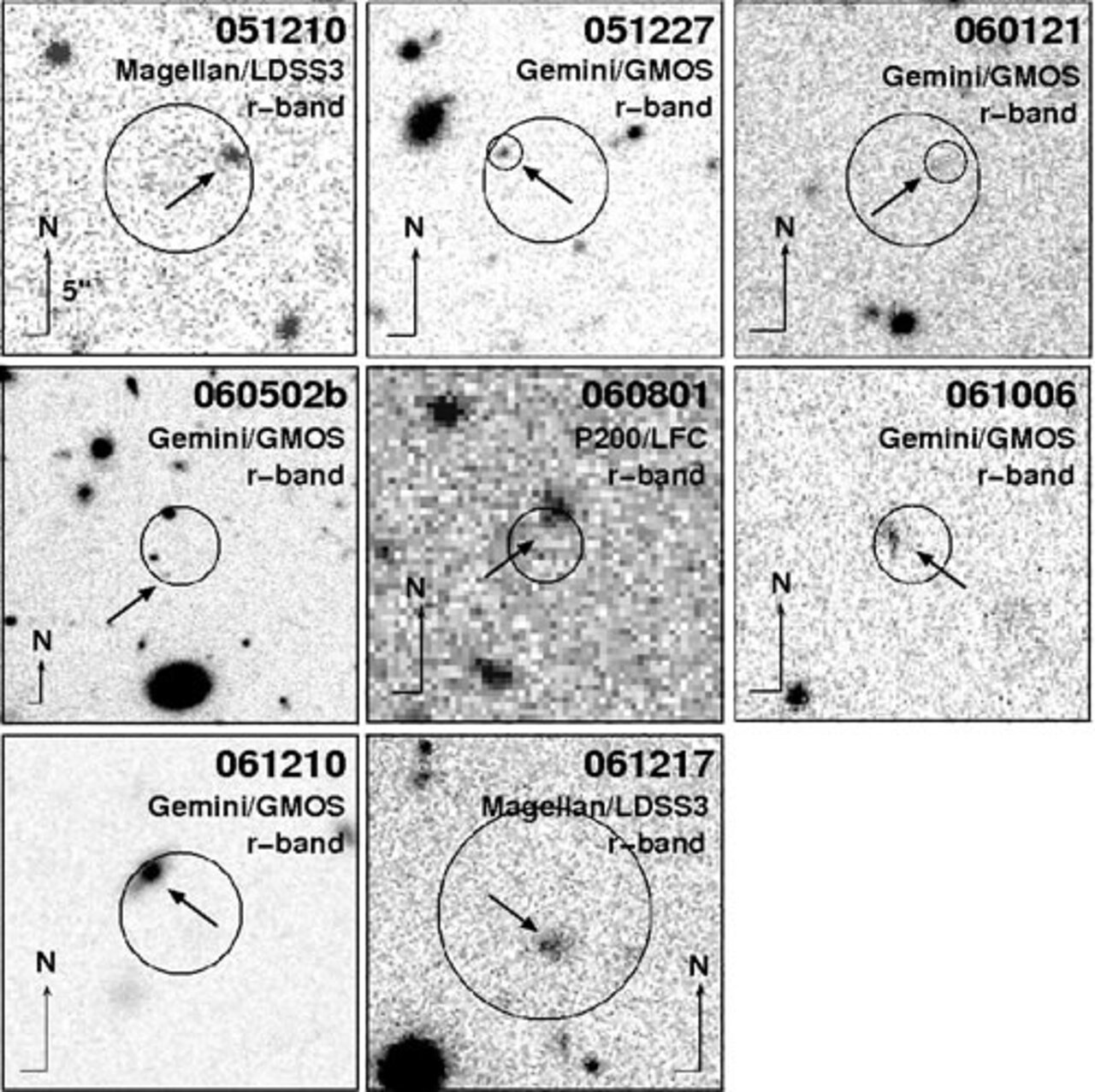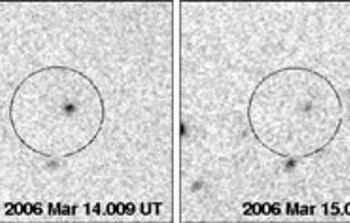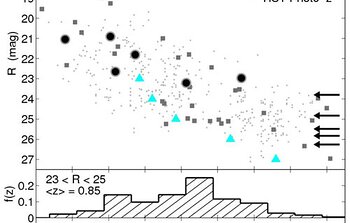Are Short Gamma-ray Bursts Cosmic Tricksters?
April 18, 2007

Analysis of nine short gamma-ray bursts (GRBs) observed with Gemini, Magellan, and the Hubble Space Telescope reveals that the progenitors of these GRBs may reside in faint host galaxies at redshifts of z = 1.1 and beyond (geminiann07004a). Unexpectedly, the host galaxies of these short GRBs (with R ~ 23-27 mag) can be more than a 100 times fainter than those of previously known short GRBs (brighter than R ~ 22 mag) (geminiann07004b). Therefore the hosts of the recently observed short GRBs are starkly different from the first few short GRBs hosts, which were all at z < 0.5. It seems that our understanding of the nature of GRB progenitors may be undergoing a paradigm shift.
Although initial observations suggested that short GRBs occur at significantly lower redshifts than long GRBs (which occur at z ~ 3), the recent observations establish for the first time that a third or more of all short GRBs originate at high redshift, and that some bursts produce 1051-1053 erg in their brief, but intense emission. This is at least two orders of magnitude larger than for low redshift short bursts. The existence of low redshift short GRBs has been used to argue for long progenitor lifetimes (> 10 Gyr) and against a substantial population of short GRBs at high redshift. The clear magnitude–redshift relation for short GRBs suggests that the faint host galaxies discussed in this paper are located at z ~ 1 (geminiann07004c). This is indeed confirmed by spectroscopy of several of the host galaxies (geminiann07004d).
Gamma ray bursts are among the most energetic explosions in the universe. They have been known to exist since 1967 when they were first detected serendipitously by the Vela military spacecraft, which was built and launched to detect man-made nuclear explosions in the upper atmosphere or in near-Earth space. It was 30 years later, in 1997, that their origin was associated with very energetic events happening in distant galaxies. There are two classes of gamma-ray burst: the long-soft bursts (surmised to be associated with the death of some massive stars) and the short-hard bursts, thought to be the catastrophic energy output of merging massive stellar remnants, like neutron stars or black holes. These new observations show that short GRBs are not necessarily associated with progenitors that are several billions years old. Furthermore, the existence of a population of short GRBs at high redshifts implies that the energy release of some events may be larger than previously suspected.
Finally, the authors emphasize the very interesting possibility of detecting gravitational waves from short GRBs, particularly if they originate from compact object mergers. Detection would provide insights about the underlying system (e.g. degree of beaming, masses of the constituents), while non-detection would rule out the binary merger model. The advanced Laser Interferometer Gravitational Observatory (LIGO) could detect 2 to 6 events per year. Hence the simultaneous operations of advanced LIGO and of a gamma-ray satellite are of crucial importance to understand fundamental aspects of the physics of massive objects and test the validity of General Relativity in strong gravitational fields.
Links
- “A New Population of High Redshift Short-Duration Gamma-Ray Bursts”, by Edo Berger et al. in The Astrophysical Journal.
E. Berger is part of a large collaboration that uses the Gemini telescopes to study both long- and short-duration GRBs. Other team members are A. M. Soderberg, D. B. Fox, P. A. Price, B. P. Schmidt, A. Cucchiara, S. B. Cenko, S. R. Kulkarni, D. A. Frail, B. E. Penprase, A. Rau, E. Ofek, S. J. Bell, P. B. Cameron, L. L. Cowie, M. A. Dopita, I. Hook, B. A. Peterson, Ph. Podsiadlowski, K. C. Roth, R. E. Rutledge, S. S. Shepard, A. Songaila, A. Gal-Yam, and E. Nakar.



